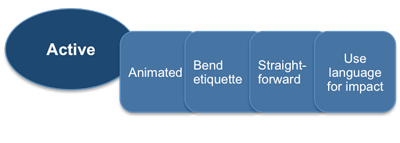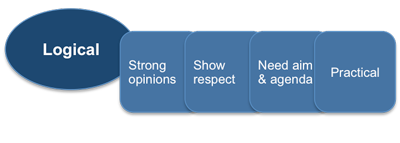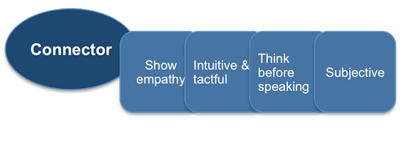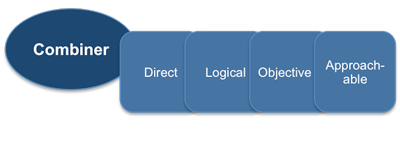Recognizing Workplace Communication Styles
'Active' Communicators
'Active' communicators come across as direct and confident in discussions, regardless of the extent of their knowledge on the subject. They will quickly state their point, summarize discussions, and make decisions. They don't like to be interrupted or excluded and will fill any silences or pauses.
Active communicators are individuals whose words and body language are expressive. The words they use in conversations will make an impact and may often bend the rules of etiquette.
 |
You may recognize members of you team who act this way and you may be aware that they have a tendency to talk things up. Their ability to listen to others is often overshadowed by their enthusiasm for talking and being part of the discussion.
'Logical' Communicators
There are other individuals who, like Active communicators, express their opinions with conviction, but who otherwise have quite different attributes. 'Logical' communicators can be recognized by their respectful and practical manner. You can often identify these individuals by their tendency to use their own past experiences to inform them about how current issues should be dealt with.
 |
Logical communicators like a logical framework for their communications, i.e. timed agendas that are adhered to, and a stated aim. They prefer to see supporting written evidence and tend to judge people by how they deliver what they say they will do.
You will also hear Logical communicators frequently using language of extremes. For example:
- Users always do…
- You'll never get them to accept…
'Connector' Communicators
There are others within your team that can be singled out because they always try to prevent discussions becoming confrontational and have a need to involve everyone. These individuals are 'Connector' communicators, born diplomats who are tactful and considerate of others in the discussion and of their point of view.
Their style of communication makes them approachable and empathetic. They often encourage general discussions at the start of a meeting so that they can gain an understanding of each person.
 |
You can see that these individuals with their intuitive ways and affinity with the feelings of others will irritate the Logical and Active communicators. But Connectors are good to have in discussions because they will carefully consider an issue before voicing their opinion, thereby often bringing balance into discussions.
'Thinker' Communicators
The trait of thinking before speaking is a characteristic Connectors share with 'Thinker' communicators. But there the similarities end. Thinker communicators will be objective, while Connectors tend to be subjective. Those who have a Thinker communications style seek out facts and figures rather than feelings to support what they say. Without such supporting evidence such individuals are reluctant to speak. They will portray controlled body language throughout conversations whether they are talking or listening.
 |
You can recognize the Thinkers in your team because they will be individuals who are happy to talk about abstract ideas and strategies. Their communications are most effective in small rather than large groups.
'Combiner' Communicators
The characteristics of the 'Combiner' communicators mean that they are able to adapt themselves to suit their audience. They can be objective or direct. They can lead discussions and draw in contributions from others.
Such individuals show respect to others and have the ability to draw together disparate conversations into a coherent argument that aids decision-making. They are comfortable with using facts as well as relying on their intuition. Their adaptability and skills in reading and matching situations make them excel when communicating.
 |
Remember, even Combiners have a preferred style, so the best way to emulate them is to watch how these individuals adapt their natural communication style. These observations will help you to understand how they use their body language, words, and behaviors to alter their style of communication.
This knowledge of how others communicate will help you to develop your own communications skills. As with body language, being able to 'mirror' the other person's communications style will create a positive atmosphere for the exchange to take place in.
This does not mean you have to only communicate in this style. But by starting in a style and manner similar to the other member of the exchange you create a positive environment you can both feel comfortable in. This will make your objective easier to attain. This Communication Style Checklist will help you to identify your own preferred communication style.
You may also be interested in:
Effective Communication in the Workplace | Workplace Communication Styles | Perceptual Preferences | Attitudes to Communications | Communication Research | Using the RESULT Principle | Barriers to Communication.



